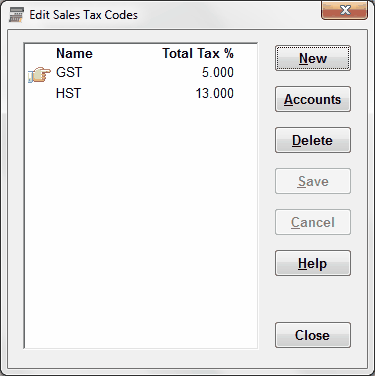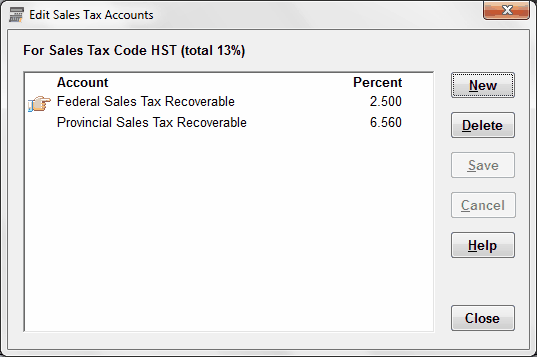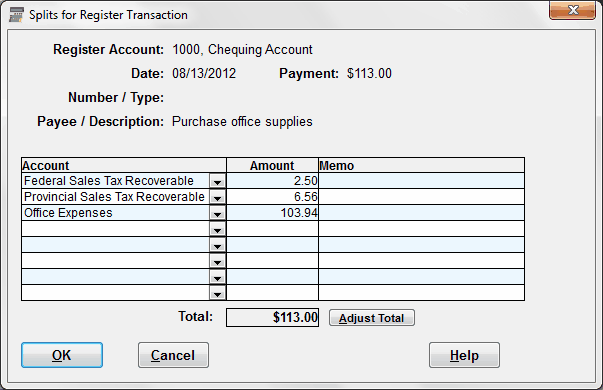Please the help page Handling Sales Taxes, if you have not already done so, before you try to use this window. There is also a video demonstration of the setup described in this help topic, which you can find here.
As explained there, charities in Canada are eligible for rebates on sales taxes they pay on purchases. As a result, it is necessary to track either all of those sales taxes, or the part that is eligible for rebates. (Since charities in the USA generally do not pay sales tax, this is probably not important to them.)
To make it easy to track sales taxes, ACCOUNTS supports Sales Tax Codes linked to accounts, with automatic allocation of a percentage of a total purchase price. To start setting up these codes, use the Maintenance ⇒ Sales Tax Codes menu option. That bring up the following window (in which we have filled in a couple of taxes, as a sample):

The entries on this window record a Name you want to give to a sales tax (which becomes a code you can associate with a transaction on the Register and other data entry windows), and the Total Tax %, i.e. the percentage on top of the base purchase price that this tax represents. So if as in the example above GST is entered at 5%, that means on a $100 purchase on which only GST is applicable, you will pay a total of $105 including tax.
No matter which of the methods you are using from the page Handling Sales Taxes, the tax rates entered on this window must be the total percentages for those taxes, not the total recoverable percentage.
Do not enter percentage signs as part of the Total Tax % field - just enter a number.
The controls on this window are mostly similar to those on other maintenance windows in ACCOUNTS. Click New to create a new row for a new Sales Tax Code and its percentage. Just click into an existing value to edit it. In either case, once you start editing, only the Save and Cancel buttons are active - click Save to save your changes, or Cancel to cancel them.
Click Delete to prompt to delete the code that the hand pointer is pointing at. (Click into a field on a different row to change which row the hand pointer points at.) You cannot delete codes that are in use in transactions in a register window.
Click Help to view this help page. Click Close to close this window.
Associating Accounts with Codes
Click Accounts in the window above, with the hand pointing to the desired Sales Tax Code, to bring up the following window, used to associate accounts and percentages with the pointed-to code.
Every sales tax code must have associated accounts, or it will not be displayed in drop-down lists of such codes, because it would have no effect! If you try to exit the window above when you have a sales tax code with no associated accounts, you will be warned about this.
Again, we have filled the sample below, with values appropriate for Ontario as of 2016:

The example above corresponds to the example of handling several Canadian provinces' 13% HST, given in the Method 1 section of the under Handling Sales Taxes Help page.
The controls on this window work basically the same as those on the Edit Sales Tax Codes window - New to create a new row for a new account and its percentage, click into an existing row to edit a value there, Save to save such changes, Cancel to cancel such changes, Delete to prompt to delete the pointed-to row, Help to see this page, and Close to close the window.
The Account field in a row on this window is selected from a drop-down list of all accounts that might be used for different types of sales tax handling. (The program cannot really know the meaning of your accounts, so all Asset, Liability, Income and Expense accounts that don't have sub-accounts are shown as options.) There is an "<Add New>" option on this field's drop-down list, which pops up the window for adding a new account, so you can add any accounts you need that were not already there.
The Account field normally drops its list down automatically, as soon as you Tab or click into it. It is initially displayed in chart of accounts order, but if you type a letter, it immediately goes to the first account that starts with that letter, and also re-sorts the list in alphabetical order, to make it easier to see and select other accounts that start with that letter. If you press Backspace after that, or Tab out of the field, the list is returned to chart of accounts order.
The Account field uses autocomplete to make selecting existing account names easy.
The Percent field indicates the percentage of the base purchase price (before the Total Tax % from the Sales Tax Code was applied) that is to be allocated to its corresponding Account, when this Sales Tax Code is applied to a new transaction. Do not enter percentage signs as part of the Percent field - just enter a number.
The percentages in this window do not have to add up to the total percentage in the Edit Sales Tax Codes window, though they cannot exceed that amount. The ones in this window are the actual percentages that will be split out when using sales tax codes in transactions. The ones in the Edit Sales Tax Codes window must be the total percentage of that type of tax, like 5% for GST.
Example of using a Sales Tax Code in a Register window
For an example using the values shown in the window above, suppose a purchase was made for $100, with 13% HST, for a total cost of $113. You enter this into a register window, with a Purchase amount of 113, and an appropriate transaction Account (say "Office Expenses"). You select "HST" in the drop-down for the Tax Code (following the Memo field). Although you do not have to do so, if you open the Splits window (before or after saving the transaction), you will see the following automatic breakdown that the use of the Sales Tax Code has caused:

The $2.50 for Federal Sales Tax Recoverable was calculated by the program based on the $100 base price before the 13% HST tax was added on, and the 2.5% specified in the Edit Sales Tax Accounts window for that tax account. Similarly, the $6.56 is based on the 6.56% specified for Provincial Sales Tax Recoverable. The $100 base price was calculated by figuring out what the price had to be, given that the price you paid that included HST (which is specified to be 13% in the Edit Sales Tax Codes window) was $113.
Note that after saving a register transaction that uses a Sales Tax Code, the Account field will show "--- SPLIT ---", because of the automatic split of the transaction that the use of that code has caused. You do not have to open the splits window for this to happen!
Changing the percentages or associated accounts for a sales tax code in the Maintenance ⇒ Sales Tax Codes window (and its popup Accounts window) for existing Tax Codes that have already been assigned to register transactions does not affect those transactions in any way. It only affects new transactions that are entered using that Tax Code.
The Write Cheques, Enter Deposits, Credit Card Charges and Pay Bills windows also allow you to select a Tax Code, and do the splits in the same way (though you don't have to enter a separate splits window to see that).
This topic was last edited on May 27, 2022